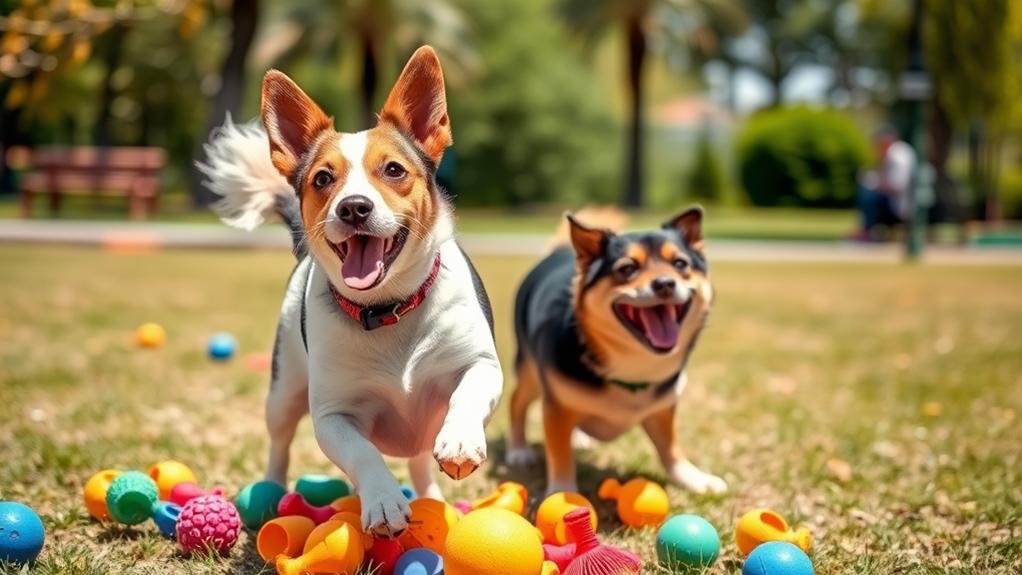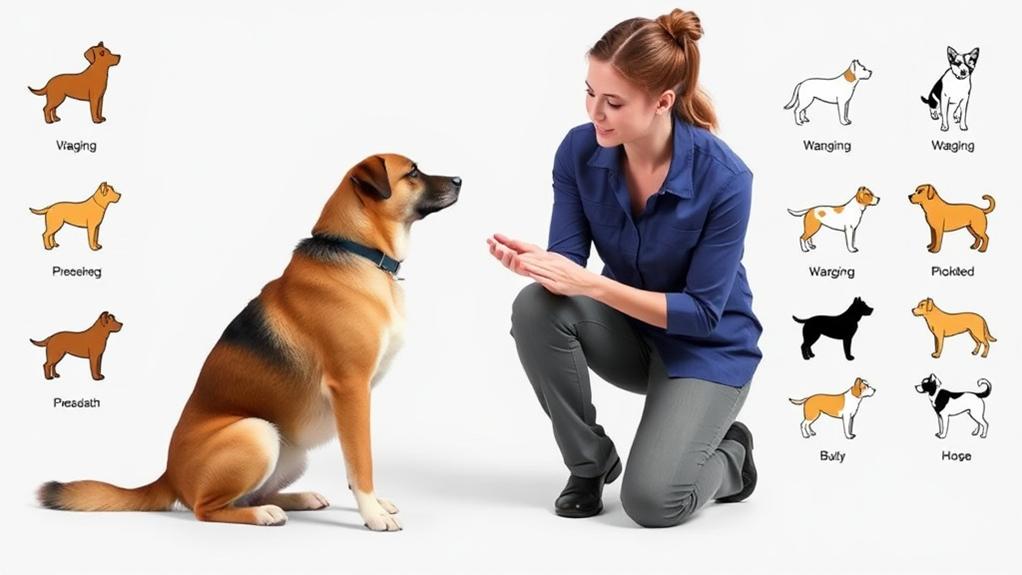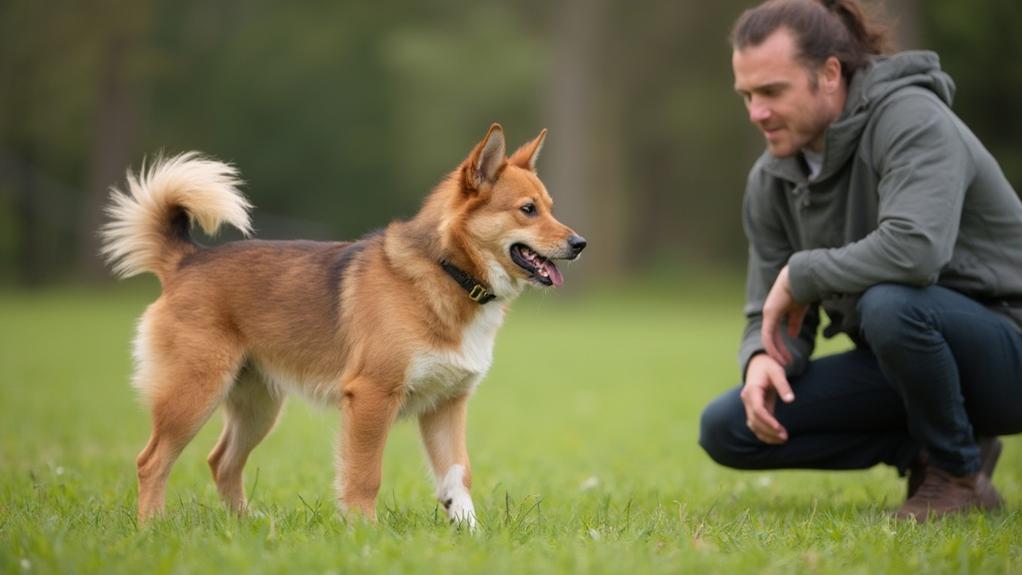Learning your dog’s body language is vital for effective training. By observing their posture, tail movements, and facial expressions, you can gauge their emotions and needs. For example, a wagging tail often signals excitement, while a tucked tail might indicate fear. Recognizing these signals helps you decide when to introduce new commands or when to pause if your dog shows signs of stress. By responding to their body language with positive reinforcement, you create a supportive training environment. This understanding strengthens your bond and makes training sessions more productive. Keep exploring to uncover more insightful tips!
Importance of Body Language
Understanding dog body language is indispensable for any dog owner. It’s your key to deciphering your pet’s emotions and needs. When you grasp how your dog communicates through physical cues, you can better respond to their feelings, creating a stronger bond between you both.
Recognizing these signals can also enhance your training efforts. Instead of relying solely on verbal commands, you’ll learn to interpret your dog’s posture, tail movements, and ear positions. This understanding allows you to adjust your training techniques to align with your dog’s comfort level and emotional state.
Moreover, being aware of your dog’s body language can help you prevent misunderstandings. A dog that appears relaxed and wagging its tail might be excited, while a dog with a tucked tail and lowered ears may feel fearful or threatened. By paying attention to these signals, you can intervene in situations that may lead to stress or aggression.
In short, understanding dog body language equips you with essential tools for effective training, enhances communication, and fosters a nurturing environment for your furry friend. This knowledge makes you a more responsible and empathetic dog owner.
Common Canine Signals

Dogs have their own unique ways of expressing themselves, and recognizing common canine signals can make all the difference in your relationship with your furry friend. By understanding these signals, you can respond appropriately and strengthen your bond.
Here’s a quick reference table of some common canine signals:
| Signal | Meaning |
|---|---|
| Tail Wagging | Happy or excited |
| Barking | Alert or seeking attention |
| Whining | Anxious or wanting something |
Pay attention to these signals during your interactions. A wagging tail usually indicates joy, while barking can show excitement or alertness. Whining might suggest your dog is feeling anxious or wants your attention.
Additionally, look for signs like yawning or lip licking, which may indicate stress. By tuning into your dog’s signals, you’ll be better equipped to respond to their needs. This awareness can lead to more effective training and a happier, healthier pet. Remember, your dog’s communication goes beyond barks—it’s all about understanding the nuances of their body language!
Posture and Positioning
A dog’s posture and positioning can reveal a lot about its emotional state and intentions. By observing how your dog stands, sits, or lays down, you can gain insights into its feelings and needs. Here are some key postures to watch for:
- Relaxed: A dog stands or sits with a loose body, mouth slightly open, and tail in a neutral position. This indicates comfort and contentment.
- Alert: If your dog stands tall with ears perked up and a stiff body, it’s likely paying close attention to something. This posture signals curiosity or concern.
- Submissive: A dog that crouches low, tucks its tail, and avoids direct eye contact is expressing submission. This can indicate fear or a desire to appease.
- Defensive: If your dog stands with its body tense, hackles raised, and may even lean forward, it’s feeling threatened or ready to protect itself.
Understanding these postures can greatly enhance your training efforts. By responding appropriately to your dog’s body language, you can foster a stronger bond and create a more effective training environment. Keep an eye on these subtle clues!
Tail Movements Explained
Pay attention to your dog’s tail movements; they can tell you a lot about its mood and intentions. A wagging tail usually indicates excitement or happiness, but the speed and position matter too. If your dog’s tail is wagging quickly and held high, it’s likely feeling joyful and enthusiastic to engage. However, if the wagging is slow and the tail is held low, your pup might be unsure or submissive.
A stiff, raised tail often signals alertness or confidence, especially in breeds known for guarding. Conversely, a tucked tail demonstrates fear or submission, indicating your dog may feel threatened or anxious. If your dog’s tail is wagging while it’s standing still, it could be a sign of curiosity or interest.
When interpreting tail movements, consider the context. For example, if your dog is wagging its tail but also has a tense body or raised hackles, it may be feeling conflicted. Tail movements are essential cues in understanding your dog’s emotional state. By observing these signals, you can better respond to your dog’s needs and strengthen your training efforts.
Facial Expressions to Watch

Understanding your dog’s facial expressions can reveal a wealth of information about its emotions. By paying attention to these subtle cues, you can enhance your training efforts and strengthen your bond.
- Relaxed Face: When your dog’s face appears soft, with a slightly open mouth and relaxed eyes, it’s feeling calm and content. This is a great time for training or bonding activities.
- Tensed Jaw: A tight jaw and closed mouth often signal stress or anxiety. If you notice this, it might be best to give your dog some space or adjust your training approach.
- Raised Eyebrows: When your dog raises its eyebrows, especially the inner ones, it’s showing curiosity or interest. Use this moment to engage your dog with new commands or tricks.
- Whale Eye: If you see the whites of your dog’s eyes, it could indicate discomfort or fear. Approach with caution and reassess the situation to safeguard your dog’s wellbeing.
Ears and Their Meanings
Ears are key indicators of your dog’s emotions and intentions. When your dog’s ears are perked up and facing forward, it’s often an indication of curiosity or excitement. This position shows that your pup is paying attention to what’s happening around them. On the other hand, when the ears are flattened against the head, it may signal fear, submission, or anxiety. In this state, your dog might be feeling threatened or unsure.
If your dog’s ears are in a neutral position, they’re likely relaxed and feeling comfortable in their environment. You should also pay attention to the angle of the ears; slightly turned ears can indicate that your dog is unsure or trying to assess a situation. A quick flick of the ears back and forth can suggest that your dog is feeling playful or is trying to communicate with you.
Understanding Playful Behaviors

When your dog bounds across the yard with a wagging tail and playful barks, it’s clear they’re ready for some fun. Understanding their playful behaviors can enhance your bond and make training sessions more enjoyable. Here are some key signs to look for:
- Play Bow: When your dog lowers their front legs while keeping their rear in the air, they’re inviting you to play.
- Chasing: If your dog runs back and forth, it’s a sign they’re excited and want to engage in a game of chase.
- Barking: Playful barks are usually higher-pitched than barking out of aggression. They often indicate joy and fervor.
- Zoomies: Sudden bursts of energy where your dog runs around in circles show they’re feeling playful and need to burn off some energy.
Recognizing these behaviors not only helps you engage your dog in play but also allows you to incorporate fun into training. By responding positively to their playful cues, you’ll encourage a happy, well-adjusted pet, making training a rewarding experience for both of you.
Signs of Stress and Anxiety

Playtime is great for your dog’s mental and physical health, but it’s important to recognize when they’re feeling stressed or anxious. Observing their body language can give you essential insights into their emotional state.
One of the most common signs of stress is excessive yawning, which can indicate discomfort. You might also notice your dog licking their lips or panting, even if they’re not overheated. Another red flag is when they turn their head away or avoid eye contact, showing they want to disengage from a situation.
Pay attention to their tail position, too. If it’s tucked between their legs, your dog is likely feeling insecure. Conversely, a stiff tail held high can signal agitation. Additionally, if you see them pacing or unable to settle down, it’s a clear indication that something’s bothering them.
Lastly, watch for sudden changes in behavior, like increased barking or growling, as these can also suggest anxiety. By being aware of these signs, you can create a calmer environment and help your dog feel more secure. Recognizing stress early allows you to provide the support they need.
Applying Signals in Training

Understanding your dog’s body language can greatly enhance your training sessions. By recognizing and applying their signals, you can create a more effective and positive learning environment. Here are four key ways to incorporate body language into your training:
- Watch for Relaxed Signals: A wagging tail, soft eyes, and a relaxed posture indicate your dog is comfortable. Use these moments to introduce new commands or techniques.
- Recognize Stress Signs: If your dog shows signs of stress like yawning, lip licking, or turning away, it is imperative to pause the training. This gives them time to relax and refocus.
- Use Positive Reinforcement: When your dog responds well, reward them immediately with treats or praise. This helps connect their positive body language with successful training outcomes.
- Adjust Your Approach: If your dog displays uncertainty or fear, adjust your tone and energy. Be calmer and more encouraging, helping them feel secure enough to engage.
Conclusion
Understanding your dog’s body language is vital for successful training. By recognizing their signals—whether it’s a wagging tail or a relaxed posture—you can create a stronger bond and communicate more effectively. Pay attention to their facial expressions and ear positions, as these reveal their emotions. When you apply this knowledge in your training sessions, you’ll not only improve your dog’s behavior but also enhance their overall well-being. Start observing closely, and watch your training transform!



